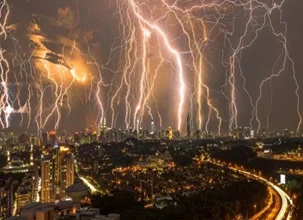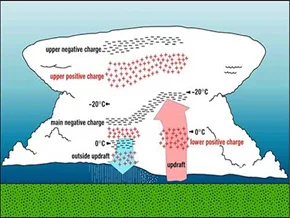Environment & Ecology
Context: According to the ‘Annual Lightning Report 2020-2021’, India has experienced an increasing loss of human lives, property, and livelihoods due to the rising frequency and intensity of lightning and thunderstorms.
- As per the report, India witnessed 18.5 million lightning strikes between April 2020 and March 2021, marking 34 percent more strikes than the previous year.
- Madhya Pradesh experienced the highest number of lightning-related deaths (162), followed by Maharashtra (121), Gujarat (72), Bihar (70), Rajasthan (49), and Chhattisgarh (40).


About Lightning:
- Lightning is a giant spark of electricity in the atmosphere between clouds, the air, or the ground.
- In the early stages of development, air acts as an insulator between the positive and negative charges in the cloud and between the cloud and the ground.
- When the opposite charges build up enough, this insulating capacity of the air breaks down and there is a rapid discharge of electricity that is known as lightning.
- The flash of lightning temporarily equalizes the charged regions in the atmosphere until the opposite charges build up again.
- Lightning can occur between opposite charges within the thunderstorm cloud (intra-cloud lightning) or between opposite charges in the cloud and on the ground (cloud-to-ground lightning).
Major Causes lightning:
- Lightning is an electrical discharge caused by imbalances between storm clouds and the ground, or within the clouds themselves.
- During a storm, colliding particles of rain, ice, or snow inside storm clouds increase the imbalance between storm clouds and the ground, and often negatively charge the lower reaches of storm clouds.
- Objects on the ground, like steeples, trees, and the Earth itself, become positively charged creating an imbalance that nature seeks to remedy by passing current between the two charges.
- This heat causes surrounding air to rapidly expand and vibrate, which creates the pealing thunder heard a short time after seeing a lightning flash.
- When the positive and negative charges grow large enough, a giant spark – lightning – occurs between the two charges within the cloud.
- Most lightning happens inside a cloud, but sometimes it happens between the cloud and the ground.
- A build-up of positive charge builds up on the ground beneath the cloud, attracted to the negative charge in the bottom of the cloud and the ground’s positive charge concentrates around anything that sticks up – trees, lightning conductors and even people.
- The positive charge from the ground connects with the negative charge from the clouds and a spark of lightning strikes.
Impacts of lightning:
- Tragic tolls due to lightning strikes:
- Between 1972 and 2019, around 90,632 people were killed due to lightning strikes, followed by floods and rain (77,724), heatwaves (34,925), landslides (26,980), cold waves (26,167), cyclones (23,315).
- Besides the loss of human life, lightning adversely impacts the agriculture, aviation, power, and communication sectors.
- Impact on rural areas:
- Mainly, rural and forest areas are the most vulnerable due to lighting because of the presence of water bodies and tall trees and almost 96 percent of deaths occurred in rural areas due to lightning compared to the urban area.
- Regarding deaths due to lightning, the population in rural areas is more vulnerable than in urban areas.
- Impact on farmers:
- Frequent lightning strikes adversely affect small and marginal farmers.
- Around 77 percent of farmers are killed due to lightning as they work in agricultural fields during the Kharif cropping season in the monsoon period.
- Impact on tribal population:
- The Annual Lightning Report 2020-2021 has confirmed that 60-70 percent of deaths occurred in tribal populations due to lightning in Jharkhand, Odisha, Madhya Pradesh, West Bengal, and other states.
Issues related to mitigation of lightning related casualties:
- There is no national-level policy to tackle lightning fatalities except for providing a lump-sum ex-gratia to the kin of the deceased person.
- The Odisha government provides 4 lakh per deceased person to the next of kin from SDRF.
- Other State governments provide lump sum Ex-gratia to the deceased person’s family.
- These policies are not adequate to minimise deaths due to lightning.
Way Forward:
- Inclusion of lightning as a natural disaster:
- The Centre should include lightning as a “natural disaster” to minimise lightning-related deaths.
- This would help States prepare long-term mitigation through coordinated efforts with local agencies and reconstruction activities to build disaster-resilient infrastructure.
- Hazard Mapping and targeted public interventions:
- In addition, some critical measures where public intervention is an absolute necessity include mapping vulnerable populations with potential lightning hotspots, improving early warning systems, and installing lightning detection systems in the local areas.
- Frequency database of lightning strikes:
- Moreover, the government should prepare a database related to the frequency of lightning strikes, gender-wise lightning deaths, and occupation-wise fatalities at the district, state and central levels for devising an action plan against lightning strikes.
- These targeted public interventions can reduce human casualties due to lightning.
- Training and community awareness programs:
- More than 70 percent of deaths from lightning occurred amongst people standing under tall trees; therefore, training and community awareness programs are essential measures to minimise deaths due to lightning.
Source: The Hindu














